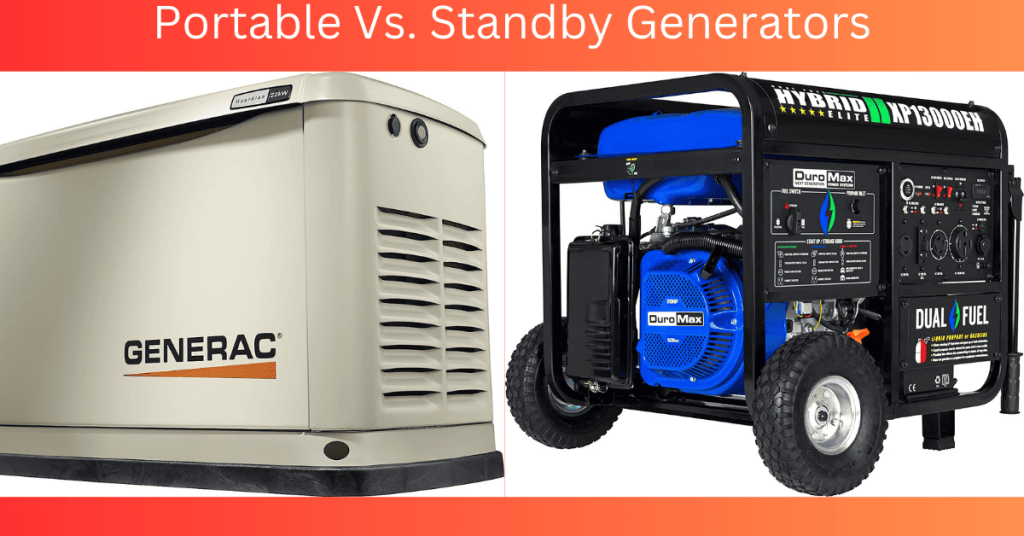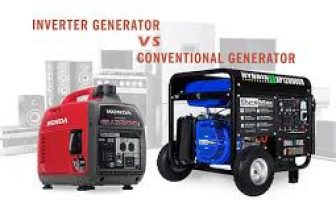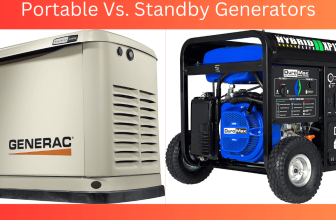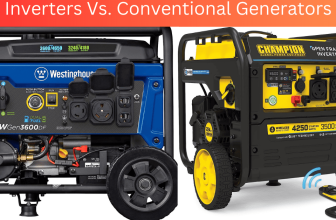Have you ever found yourself in the middle of a power outage, unable to do anything until the electricity comes back on? It’s frustrating, isn’t it? It’s like being stranded on a deserted island with no way to communicate with the outside world.
But what if there was a way to take control of the situation and keep the lights on even when the power goes out? That’s where standby and portable generators come in.
At first glance, all generators may seem equal. They all produce electricity, right? But the truth is, there are significant differences between standby and portable generators that can make or break your decision to invest in one.
In this article, we’ll explore those differences and help you determine which type of generator is the best fit for your needs. Whether you’re looking to power your home during a blackout or take your generator on the road for camping trips, understanding the differences between standby and portable generators is essential for achieving mastery over your power needs.
Key Takeaways
- Standby generators are more expensive but provide a more reliable source of power during an outage, have a higher wattage capacity, and can power the entire home for an extended period of time.
- Portable generators are smaller, more affordable, and can be moved from place to place, but are less reliable, have lower wattage capacities, and can only provide power to a limited number of appliances or devices.
- Standby generators usually run on natural gas or propane, which are more environmentally friendly than gasoline, while portable generators typically run on gasoline, which is cheaper but more polluting and requires more frequent refueling.
- Regular maintenance of both standby and portable generators is important for optimal performance and they can be a valuable investment for those who live in areas with frequent power outages or require uninterrupted power for medical equipment. The choice between standby and portable generators depends on specific needs, power needs, mobility requirements, and budget.

Overview of Standby and Portable Generators
Now, let’s dive into the differences between standby and portable generators so you can choose the right one for your needs.
Standby generators are stationary units that are permanently installed outside of your home. They’re connected to your home’s electrical system and run on either natural gas or propane. Standby generators are designed to automatically turn on within seconds of a power outage and can power your entire home for an extended period of time, making them ideal for those who live in areas with frequent power outages or for those who require uninterrupted power for medical equipment.
On the other hand, portable generators are smaller units that can be moved from place to place. They’re typically powered by gasoline or propane and are designed to provide power to a limited number of appliances or devices. Portable generators are ideal for camping trips, outdoor events, or for providing temporary power during a power outage. However, they’re not designed to power your entire home for an extended period of time.
When deciding between a standby and portable generator, it’s important to consider your specific needs and budget. Standby generators are more expensive to purchase and install, but they provide a more reliable source of power during an outage and can increase the value of your home. Portable generators are more affordable, but they require manual setup and aren’t as reliable as standby generators. Ultimately, the decision comes down to your individual needs and budget.
Up next, we’ll explore the cost comparison between standby and portable generators.
Cost Comparison
So let’s talk about the cost comparison between standby and portable generators.
When it comes to initial investment, standby generators are definitely more expensive than their portable counterparts. However, they also tend to have lower maintenance and fuel costs in the long run.
Initial Investment
Investing in a standby generator may seem expensive at first, but it ultimately pays off in the long run with its reliability and convenience. Standby generators are installed permanently outside the home and are connected to the home’s electrical system. They are designed to automatically turn on within seconds of a power outage and can run for extended periods of time.
The initial investment for a standby generator can range from a few thousand dollars to tens of thousands of dollars depending on the size and capacity of the generator. However, the convenience and peace of mind that a standby generator provides is priceless. You don’t have to worry about refueling or starting the generator, it will automatically turn on and provide power to your home during an outage.
Additionally, a standby generator can increase the value of your home and may even help you save money on your homeowners insurance. With all these benefits, it’s easy to see why investing in a standby generator is a smart choice.
Moving onto the next section, let’s explore the maintenance and fuel costs associated with standby and portable generators.
Maintenance and Fuel Costs
You’ll be happy to know that maintaining and fueling your generator doesn’t have to be a hassle. In fact, standby and portable generators have similar maintenance requirements, which mainly involve regular oil changes, air filter replacements, and battery checks.
As for fuel costs, standby generators tend to rely on natural gas or propane, which can be more expensive than gasoline used by portable generators. However, standby generators are designed to use less fuel overall, and some models can even switch between fuel sources to save money.
If you’re concerned about maintenance and fuel costs, here are a few tips to keep in mind:
- Regularly check your generator’s oil level and replace it according to the manufacturer’s recommendations.
- Keep spare air filters on hand and replace them as needed to ensure optimal performance.
- Consider investing in a fuel stabilizer to extend the life of your generator’s gasoline.
- If you’re using a standby generator, look into switching between natural gas and propane to save money on fuel.
Now that we’ve covered maintenance and fuel costs, let’s move on to the next important aspect of generators: power output.
Power Output
So, let’s talk about power output. It’s important to know the wattage capacity of a generator, as it determines what you can power with it.
Portable generators typically have lower wattage capacities than standby generators, but they can still power essential appliances like refrigerators and lights.
We’ll explore the differences between the two and help you determine which one is right for your needs.
Wattage Capacity
If you’re looking for a generator with enough power to keep your entire house running during an outage, then you’ll want to consider the wattage capacity of both standby and portable options. Think of it like the heart of the generator – the stronger it is, the more power it can pump out to keep everything running smoothly. In general, standby generators have a higher wattage capacity than portable generators, which makes them a better choice for whole-house backup power. However, there are some high-wattage portable generators on the market that can rival the power output of standby generators.
To give you an idea of the wattage capacity differences between standby and portable generators, here’s a comparison table:
| Generator Type | Wattage Capacity |
|---|---|
| Standby | 5,000 – 20,000+ watts |
| Portable | 1,000 – 12,000 watts |
As you can see, standby generators have a much higher wattage capacity than portable generators. This means they can power more electrical devices and appliances simultaneously. However, portable generators can still be a good choice for emergency backup power if you only need to power a few essential appliances. In the next section, we’ll explore the ability of standby and portable generators to power essential appliances.
Ability to Power Essential Appliances
When it comes to powering essential appliances during an outage, it’s important to know which type of generator best fits your needs.
Standby generators are designed to power your entire home, including essential appliances like refrigerators, freezers, air conditioning units, and even medical equipment. They are connected directly to your home’s electrical system and can turn on automatically when power is lost, providing seamless backup power.
Portable generators, on the other hand, are more suited for powering essential appliances in smaller spaces, such as a single room or a small apartment. They typically have a lower wattage capacity than standby generators, so they cannot power as many appliances at once. However, they are more mobile and can be taken with you on the go, making them a great option for camping trips or outdoor events.
It’s important to consider the specific appliances you need to power when choosing between standby and portable generators.
When considering a generator, it’s also important to think about the fuel source. Standby generators are typically connected to your home’s natural gas or propane line, while portable generators run on gasoline, diesel, or propane. Understanding the differences in fuel sources can help you choose the best generator for your needs.
Fuel Source
One major difference between standby and portable generators is the fuel source they use – but have you ever wondered which fuel is more efficient and cost-effective in the long run? Standby generators usually run on natural gas or propane, which are more expensive than gasoline but offer a cleaner burn and require less maintenance.
On the other hand, portable generators typically run on gasoline, which is cheaper but more polluting and requires more frequent refueling. To help you understand the differences between the fuel sources used by standby and portable generators, here are three important things to consider:
- Natural gas and propane are more environmentally friendly than gasoline because they produce less greenhouse gases and air pollutants. Moreover, they are stored in tanks that require minimal maintenance and can last for years without needing to be replaced.
- Gasoline, on the other hand, is widely available and easy to store, but it is more prone to spoilage and requires more frequent refueling. Moreover, gasoline engines tend to be more noisy and less efficient than natural gas or propane engines, which can increase your operating costs in the long run.
- If you are looking for a generator that can power your home during extended outages, a standby generator is the way to go. These generators are connected to your home’s natural gas or propane lines, which means they can operate for weeks without needing to be refueled. However, if you only need a generator for occasional use or for outdoor activities, a portable generator powered by gasoline may be a more cost-effective option.
Now that you know about the different fuel sources used by standby and portable generators, let’s move on to the next section about installation and setup. We’ll show you how to get your generator up and running in no time!
Installation and Setup
When it comes to installation and setup, we highly recommend seeking professional help for standby generators. Their installation involves connecting to the home’s electrical system, which requires a licensed electrician.
On the other hand, portable generators are relatively easy to use and require less installation work, making them a more convenient option for those who need power on-the-go.
Professional Installation for Standby Generators
Getting a professional installation for your standby generator is essential for ensuring your family’s safety during power outages. A licensed electrician will ensure that your generator is properly installed and connected to your home’s electrical system, preventing potential safety hazards such as electrocution or fire. They’ll also make sure that your generator is set up correctly according to local building codes and regulations.
In addition, a professional installation will ensure that your generator is in good working condition and ready to use when you need it most. Regular maintenance and inspections will be performed to keep your generator running smoothly and efficiently. With a professional installation, you can have peace of mind knowing that your standby generator is a reliable backup power source for your home.
Now, let’s move on to the next section and explore the ease of use for portable generators.
Ease of Use for Portable Generators
Using a portable generator is easy and convenient for you, as you can simply plug in your appliances and power them up. Imagine being able to enjoy a hot cup of coffee and watch your favorite TV show during a power outage, thanks to your trusty portable generator.
Here are three reasons why using a portable generator is so easy and user-friendly:
- Portability: With a portable generator, you can take it with you wherever you go. Whether you’re camping in the great outdoors or staying in a cabin without access to electricity, a portable generator can provide power to keep your devices charged and your lights on.
- Simple Operation: Most portable generators are designed to be user-friendly, with simple controls and easy-to-understand instructions. You don’t need to be an expert to use a portable generator – just plug it in and turn it on.
- Versatility: Portable generators are capable of powering a wide range of appliances and devices, from small electronics like cell phones and laptops to larger appliances like refrigerators and air conditioners. This makes them incredibly versatile and useful in a variety of situations.
As you can see, using a portable generator is a breeze. But what about mobility and portability? Let’s explore that in the next section.
Mobility and Portability
So, when it comes to generators, we’ve noticed that there are a few limitations with standby generators. They’re not very mobile and you need to have them professionally installed.
That being said, we’ve found that portable generators are much more flexible and easy to move around, making them a great alternative.
Limitations of Standby Generators
Although standby generators can provide a reliable source of backup power during outages, their limitations should be carefully considered before making a purchase decision. Firstly, standby generators are generally more expensive than portable generators due to their larger size and permanent installation. This can be a significant investment for homeowners, especially if they live in areas that experience frequent power outages.
Additionally, standby generators require regular maintenance to ensure they’re in good working condition. This can include tasks like oil and filter changes, battery checks, and fuel stabilizer treatments, which can add up in cost over time.
To further illustrate the limitations of standby generators, here are three important factors to consider before making a purchase decision:
- Standby generators require a professional installation, which can add to the overall cost of the unit.
- Standby generators may not be able to power an entire home during an outage, especially if the home has high energy demands or multiple appliances running simultaneously.
- Standby generators may also be subject to local noise regulations, which can limit their use in residential areas.
Despite these limitations, standby generators can still be a valuable investment for those who prioritize uninterrupted power during outages. However, for those who value flexibility and mobility, portable generators may be a better option.
Flexibility of Portable Generators
Although standby generators have their advantages, they also come with their fair share of limitations. One of the biggest drawbacks of standby generators is that they’re not as flexible as portable generators. Standby generators are permanently installed and connected to your home’s electrical system, which means they can’t be easily moved around. This lack of mobility severely limits their usefulness in situations where you might need power in multiple locations or where you need to take your generator with you on the go.
This is where portable generators really shine. Portable generators are designed to be easy to move around and set up wherever you need them. They come in a variety of sizes and power output levels, so you can find one that fits your needs perfectly. Plus, because they’re not permanently installed, you can use them in a variety of situations, whether you’re camping, tailgating, or dealing with a power outage at home. To help illustrate the differences between standby and portable generators, we’ve put together the following table:
| Standby Generators | Portable Generators |
|---|---|
| Permanently installed | Easy to move around |
| Connected to home’s electrical system | Standalone units |
| Limited mobility | High mobility |
| High power output | Variety of power output levels |
| Expensive | More affordable |
Determining the best fit for your needs will depend on a variety of factors, including how much power you need, how frequently you need it, and how portable you need your generator to be. By understanding the differences between standby and portable generators, you’ll be better equipped to make an informed decision about which type of generator is right for you.
Determining the Best Fit for Your Needs
When choosing between standby and portable generators, it’s essential to determine which one is the best fit for your specific needs. Here are a few things to consider when making this decision:
- Power Output: If you’re looking for a generator that can power your entire home during an outage, a standby generator is likely your best bet. These generators are designed to provide a high level of power output and can connect directly to your home’s electrical system. On the other hand, if you’re looking for a generator that can power a few essential appliances or tools, a portable generator may be more appropriate.
- Mobility: One of the biggest advantages of a portable generator is its mobility. If you need a generator that you can take with you on the go or move around your property, a portable generator is the way to go. Standby generators, on the other hand, are typically installed permanently and cannot be easily moved.
- Cost: In general, standby generators are more expensive than portable generators. This is because they are designed to provide a higher level of power output and are often installed by professionals. If cost is a concern, a portable generator may be a more affordable option. However, it’s important to keep in mind that a portable generator may not be able to power your entire home during an outage.
Choosing between a standby and portable generator comes down to your specific needs. If you need a generator that can power your entire home during an outage and you’re willing to invest in a permanent installation, a standby generator may be the way to go. However, if you need a generator that is portable and more affordable, a portable generator may be a better fit. Consider your power needs, mobility requirements, and budget when making this important decision.
Frequently Asked Questions
What is the lifespan of a typical standby generator?
Typically, standby generators have a lifespan of around 20-30 years with proper maintenance. Regular service and upkeep can extend the life of the generator and ensure it’s there when you need it most.
Can portable generators be used indoors?
Using a portable generator indoors is not recommended due to the risk of carbon monoxide poisoning. However, with proper ventilation and safety measures, it can be done. Remember to always prioritize safety.
How do I maintain my generator to ensure optimal performance?
To maintain optimal performance, we regularly change the oil and air filter, inspect spark plugs, and keep the generator clean and dry. We also test it monthly and store it properly. Following these steps ensures our generator is always ready when we need it.
What safety measures should I take when using a generator?
When using a generator, we need to prioritize safety. Always keep the generator outside in a well-ventilated area, and don’t touch it with wet hands. Use proper extension cords and never overload the generator.
Is it possible to connect a standby generator to solar panels for backup power?
Yes, we can connect a standby generator to solar panels for backup power. This provides a reliable backup solution that is environmentally friendly and sustainable. We recommend consulting a professional to ensure proper installation and compatibility.
Conclusion
In the end, choosing between a standby and portable generator ultimately comes down to your specific needs and preferences.
While a standby generator may offer more power and convenience, it also comes with a higher price tag and requires professional installation.
On the other hand, a portable generator is more affordable and versatile, but may not provide enough power for larger appliances or extended outages.
Like two sides of a coin, each type of generator has its pros and cons.
It’s important to weigh these factors carefully and choose the option that best suits your lifestyle and budget.
Whether you need a reliable backup power source for your home or a portable generator for your next camping trip, both standby and portable generators can provide the peace of mind and convenience you need.
So go ahead and power up, knowing that you’ve made the right choice for your needs.





